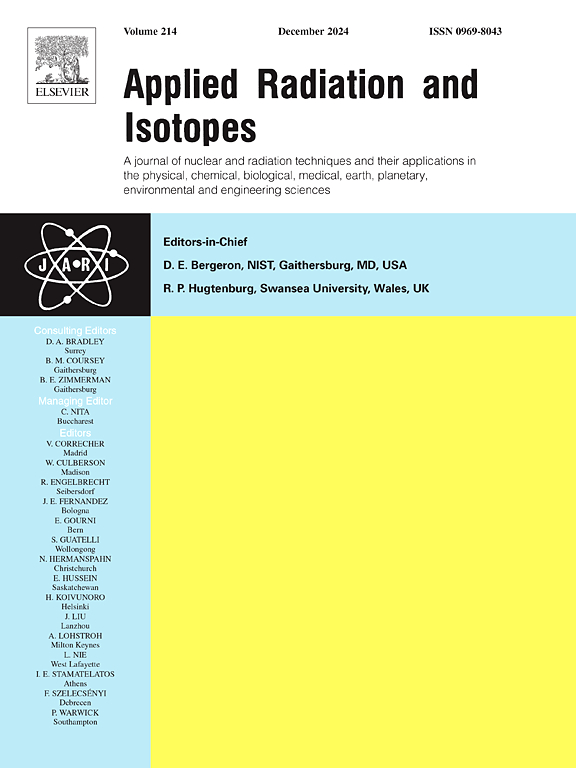单独居石砂基质的制备和均匀性:40K, 226Ra, 228Ra和214Pb活度浓度测量的候选参考物质
IF 1.6
3区 工程技术
Q3 CHEMISTRY, INORGANIC & NUCLEAR
引用次数: 0
摘要
认证标准物质(CRM)的生产是改善和维持全球一致测量系统的重要活动。crm是高计量可靠性的分析标准,用于校准、质量控制、方法验证和结果准确性的确定。这项工作的重点是根据ISO/IEC 17034开发一种富含独居石的砂标准。“Praia da Areia Preta”位于巴西东南部的瓜拉帕里,以其高于平均水平的232浓度而闻名。尽管对这种类型的砂(独居石)进行了广泛的研究,但没有计量参考(标准)。同质性是crm最重要的特征之一,本研究采用方差分析(ANOVA)的统计方法对放射性核素进行了验证。均匀性被定义为一种特性在整个材料中随机分布的程度。在实践中,一个CRM候选产品只有在其各种小瓶的内容物之间的差异不足以影响其预期用途时才被认为是充分均匀的,如指南33中规定的那样。本研究中每种放射性核素的平均活度浓度及其不确定度分别为:(33.8±1.4)Bq kg−1 (40K);226Ra为(44.56±0.36)Bq kg−1;228Ra为(416.12±0.68)Bq kg−1;214Pb为(43.96±0.33)Bq kg−1。CRM候选样品在整个制备批次中是均匀的。Pb和Bi (226Ra)的测量值接近,表明衰变链的测量和平衡良好。本文章由计算机程序翻译,如有差异,请以英文原文为准。
Preparation and homogeneity of a monazite sand matrix: A candidate reference material for activity concentration measurements 40K, 226Ra, 228Ra and 214Pb
The production of Certified Reference Materials (CRM) is an essential activity to improve and maintain a coherent measurement system worldwide. CRMs are analytical standards of high metrological reliability used for calibration, quality control, method validation and determination of the accuracy of results. This work focuses on the development of a monazite-rich sand standard according to ISO/IEC 17034. “Praia da Areia Preta”, located in Guarapari, southeastern Brazil, is known for its above-average concentration of 232Th. Although widely studied, there is no metrological reference (standard) for this type of sand (monazite). Homogeneity is one of the most important characteristics of CRMs, verified by the statistical method of Analysis of Variance (ANOVA) for the radionuclides in this study. Homogeneity is defined as the degree to which a property is randomly distributed throughout the material. In practice, a CRM candidate is only considered sufficiently homogeneous when the contents of its various vials do not differ sufficiently from each other to affect their intended uses, as specified in Guide 33. The mean activity concentrations and their uncertainty for each radionuclide in this study were, respectively: (33.8 ± 1.4) Bq kg−1 for 40K; (44.56 ± 0.36) Bq kg−1 for 226Ra; (416.12 ± 0.68) Bq kg−1 for 228Ra; and (43.96 ± 0.33) Bq kg−1 for 214Pb. The CRM candidate samples are homogeneous for the entire prepared batch. The results for Pb and Bi (226Ra) showed close values, indicating good measurement and equilibrium of the decay chain.
求助全文
通过发布文献求助,成功后即可免费获取论文全文。
去求助
来源期刊

Applied Radiation and Isotopes
工程技术-核科学技术
CiteScore
3.00
自引率
12.50%
发文量
406
审稿时长
13.5 months
期刊介绍:
Applied Radiation and Isotopes provides a high quality medium for the publication of substantial, original and scientific and technological papers on the development and peaceful application of nuclear, radiation and radionuclide techniques in chemistry, physics, biochemistry, biology, medicine, security, engineering and in the earth, planetary and environmental sciences, all including dosimetry. Nuclear techniques are defined in the broadest sense and both experimental and theoretical papers are welcome. They include the development and use of α- and β-particles, X-rays and γ-rays, neutrons and other nuclear particles and radiations from all sources, including radionuclides, synchrotron sources, cyclotrons and reactors and from the natural environment.
The journal aims to publish papers with significance to an international audience, containing substantial novelty and scientific impact. The Editors reserve the rights to reject, with or without external review, papers that do not meet these criteria.
Papers dealing with radiation processing, i.e., where radiation is used to bring about a biological, chemical or physical change in a material, should be directed to our sister journal Radiation Physics and Chemistry.
 求助内容:
求助内容: 应助结果提醒方式:
应助结果提醒方式:


